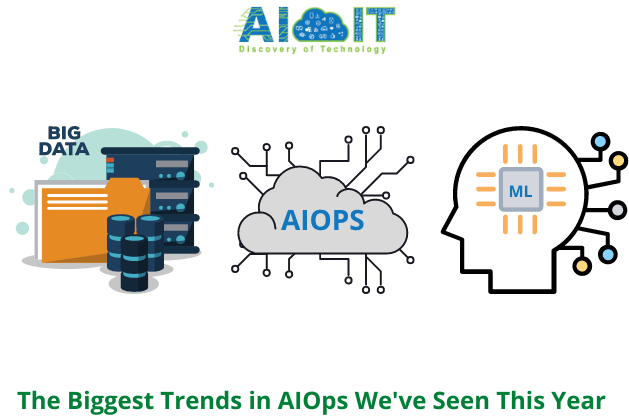AIOps has been a major buzzword in the tech industry for the past few years. But what is it, exactly? In short, AIOps is a data-driven approach to IT operations that uses machine learning and artificial intelligence to automate manual tasks, improve decision-making, and ultimately deliver better business outcomes. According to research by MarketsandMarkets, the global AIOps market will grow from $2.55 billion in 2018 to $11.02 billion by 2023, with a compound annual growth rate of 34%.
This stat shows a positive sign of how AIOps will change the IT operations’ future. By integrating AIOps, organizations can efficiently witness a reduction in outages and enhanced end-user experience.
In this article, we’ll explore some of the biggest trends in AIOps that we’ve seen emerge this year. From predictive analytics to ChatOps, these trends will significantly impact how enterprises operate in the future.
AIOps is an emerging technology
The most significant trend in AIOps this year is the emergence of artificial intelligence (AI) capabilities within technology. This has enabled AIOps to become more proactive and predictive in its IT operations management and has led to several new vendors entering the market.
AI-powered AIOps are still in their early stages, but we believe it has the potential to revolutionize IT operations management. In the coming years, we expect to see AIOps become more widely adopted and further targeting with other DevOps tools and processes.
Know More: AI vs. Machine Learning vs. Data Science
What are the benefits of AIOps?
AIOps is a relatively new term that covers a lot of ground. In general, AIOps refers to the application of big data and machine learning techniques to IT operations to automate and improve efficiency.
There are many potential benefits of AIOps. One of the most promising is its ability to help quickly identify and diagnose problems. In a traditional IT operations environment, issues can often go undetected for long periods because they are buried in mountains of data. With AIOps, machine learning can sift through this data and identify patterns that might indicate a problem. This can help get issues resolved more quickly before they have a chance to cause significant disruptions.
Another benefit of AIOps is that it can help reduce false positives. False positives are a significant issue in IT operations, as they can often lead to wasted time and resources chasing down non-existent problems. By using machine learning to analyze data, AIOps can help reduce the number of false positives by identifying which alerts are more likely to be genuine issues.
Finally, AIOps can also help improve capacity planning. By analyzing historical data, AIOps can provide valuable insight into future trends.
Read more: What are the best programming languages for AI?
How can AIOps be used?
We’ve seen some incredible trends in AIOps this year. Here are just a few ways that AIOps can be used to make your life easier:
- Automating the detection and resolution of IT incidents
- Finding and fixing problems before they cause outages
- Reducing MTTR (mean time to resolution)
- Providing real-time visibility into the health of your IT infrastructure
- Preventing outages before they happen
According to a study by Digital Enterprise Journal (DEJ), there has been an increase of 83% since 2018 in the number of organizations deploying or looking to deploy AIOps. This stat shows the critical importance of AIOps for any organization and how it benefits efficient IT operations and monitoring.
The most significant trends in AIOps this year
The past year has seen some significant changes in the world of AIOps. Here are the three most influential trends that we’ve seen this year:
1. The rise of machine learning
Machine learning is increasingly being used to automate various tasks within the AIOps workflow. This includes identifying and classifying incidents, detecting anomalies, and predicting future problems. Using machine learning, AIOps can become more accurate and efficient.
2. The growth of containers
Containers are becoming more popular as a way to deploy and manage applications. This is because they offer several advantages over traditional virtual machines, including better resource utilization and portability. As a result, many AIOps tools are now starting to support containers.
3. The expansion of cloud-based solutions
Cloud-based AIOps solutions are becoming more popular as businesses look for ways to improve agility and reduce costs. Companies can use a cloud-based solution to take advantage of scalability, pay-as-you-go pricing, and other benefits.
Also Know: Trends that Define the Future of Mobile App Development
What does the future hold for AIOps?
The future of AIOps is looking very promising. We’ve seen incredible technological advancements this year, and we can only imagine what the next few years will bring. Here are some of the biggest trends we see in AIOps:
- Machine learning and artificial intelligence will play a significant role in AIOps.
- Data analytics will continue to be a crucial part of AIOps.
- Automation will become even more critical in AIOps.
- Collaboration between humans and machines will become more common.
- The use of AIOps will become more widespread across industries.
Whether it be speed or precision, AIOps is a game-changer for your organization. It helps in making IT operations more productive and informative for any organization. Right now, it is just the initial stage for AIOps, but it will be worth it in the future. From offering exceptional user experience to delivering quality outcomes, AIOps will help shape the future of IT operations. So, integrate AIOps into your day-to-day IT operation and prepare for the future.


